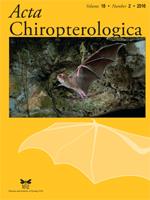The lesser horseshoe bat (Rhinolophus hipposideros) is a widespread but rare bat in central and southern Europe, having undergone a dramatic population decline in the 1950s and 1960s. However, an internationally significant population has persisted in the United Kingdom, which now appears to be increasing. The present study extends previous radio-tracking studies on R. hipposideros to confirm and extend species-specific habitat management recommendations. It is also the first to radio-track adult males in lowland England. Thirteen lesser horseshoe bats (eight males and five females, from two maternity roosts) were radio-tracked within and around the National Trust Sherborne Park Estate, Gloucestershire (UK), between June and October 2003. A total of 2599 fixes were obtained from active bats, classified as emergence circling (2.7%), commuting (10.3%), foraging (85.2%) and return circling (1.8%). Although commuting bats were mainly recorded along the edges of fields near to hedgerows or woodlands, more open commuting routes were also identified. The longest of these (used by a single bat) was in excess of 200 m through long-established open parkland during the darkest period of the night. Shorter distances (typically 30–100 m) were also flown between mature parkland trees. It is also notable that, immediately after emergence, a significant number of bats tracked from both maternity roosts crossed low over an unlit narrow two-lane country road. Habitat selection, assessed using compositional analysis based on the radio-tracking data, identified a preference for woodland habitats above all others, particularly broadleaf woodland. Wet broadleaf woodland was used for foraging by five of the 13 tracked bats. Parkland, grazed grassland and un-grazed grassland were also selected. Arable land was the least selected. This is the first study in which compositional analysis has revealed a preference for grazed over un-grazed grassland. Grazed grassland was also selected above parkland (only some of which was grazed), suggesting that the presence of cattle may be more important than mature parkland trees. Low sample sizes prohibited the use of sex-specific compositional analyses. However, it was still notable that when comparing the sexes, females showed an increased preference for woodland and a decreased preference for grassland. It is apparent from the present study that lesser horseshoe bats are flexible in their use of foraging habitat. They are able to forage within habitats other than woodland (such as scrub and isolated trees), and cross open gaps to reach these areas. However, these foraging situations are likely to be sub-optimal. Landscape management around lesser horseshoe maternity colonies should focus on optimal foraging habitats. These comprise linear landscape elements (such as hedges, tree-lines, rivers and woodland edges), woodland, and grazed parkland containing mature trees. Additionally, future conservation studies should consider both sexes, due to the possibility that sex-specific differences in habitat use exist.
How to translate text using browser tools
1 December 2016
Sex-Specific Habitat Preferences of Foraging and Commuting Lesser Horseshoe Bats Rhinolophus hipposideros (Borkhausen, 1797) in Lowland England
Nick C. Downs,
Warren J. Cresswell,
Paola Reason,
Giles Sutton,
David Wells,
Stephanie Wray
ACCESS THE FULL ARTICLE

Acta Chiropterologica
Vol. 18 • No. 2
December 2016
Vol. 18 • No. 2
December 2016
Bat
compositional analysis
conservation
habitat
lesser horseshoe




